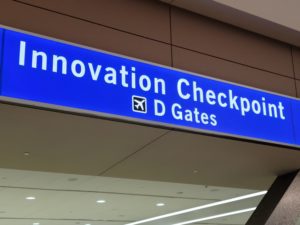
Before COVID-19, airports were struggling with some basic arithmetic. Passenger volume was going up three to five percent every year, yet the size of most airports remained the same. That meant that airport operators needed to move more people through the same physical space, and do so without letting wait times climb to prohibitive levels.
Those volumes went down during the pandemic, but that did not negate the problem. Traffic is already starting to pick back up, and now it is doing so while the screening regulations are more stringent than ever, with health scans added to more traditional security checks.
Thankfully, the air travel industry is working on its response. Guests at last week’s Future Travel Experience (FTE) Global event were treated to a tour of the Innovation Checkpoint at McCarran International Airport in Las Vegas, and the technology on display suggests that airports will be ready for travelers as more people return to the skies.
The Innovation Checkpoint is set up to give airport authorities the ability to trial new technology in a real-world setting. The Checkpoint is located on Level 0 in Terminal 3, apart from the primary security checkpoint on Level 2. On most days, the Checkpoint is a functioning security checkpoint that processes real passengers. On others – like the day of the FTE tour – McCarran can close the doors and cut off the Innovation Checkpoint from the rest of the airport to give guests the opportunity to take a closer look at the latest screening equipment.
That equipment is built to make passenger processing more efficient, and move people through security checkpoints more quickly. That can be accomplished with better identity verification technology, and with better scanning technology for luggage and people alike.
So what does the future of air travel look like? A lot like the past – but with better automation and self-service tech. Keep reading to find out more about the technologies that will soon be making their way to airports all over the world!
Leave Your Passport at Home
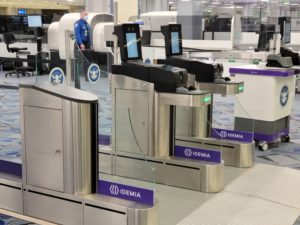
From a biometric perspective, IDEMIA’s face and document verification technology was the highlight of the McCarran tour. The company’s scanners are not yet being used to screen live passengers at the Innovation Checkpoint, but a demo was set up to give FTE guests a chance to experience a near-future identification process.
In practice, the IDEMIA offering will speed up processing times throughout the airport. As it stands, the TSA has biographic information for each traveler on each flight in the US. Passengers present their identity documents during check-in. A travel agent confirms that the document belongs to the person holding it, and compares the information on that document to the TSA Secure Flight manifest to make sure that the people checking in are indeed supposed to be on a departing flight. They then issue a boarding pass if everything is in order.
IDEMIA’s portfolio helps automate that process. With it, passengers are first asked to submit an identity document at a self-service station. They can scan the front page of their passport with a B5000 reader, or feed a more conventional card ID like a driver’s license to a touchless M500 reader that looks a bit like a horizontal toaster.
Regardless of the type of document, the machine will extract any personal information from the document, and automatically match it to the information in the manifest. It will also analyze the photo on that document to generate a biometric template. Once that process is complete, the traveler will be asked to pause for a photo, and that new photo will be matched to the template extracted from the document.
The system will then link all three pieces of information together, so that someone’s face, identity, and flight details are bound until departure. The passenger no longer needs to present an identity document or a boarding pass at subsequent checkpoints, and can instead pass through security with only a facial recognition scan.
While the facial recognition system still struggled to identify me with a mask, it had no trouble without the mask and was able to match me to my driver’s license (a Canadian one, no less) in a matter of seconds. The document read was similarly accurate, While the facial recognition system still struggled to identify me with a mask, it had no trouble without the mask and was able to match me to my driver’s license (a Canadian one, no less) in a matter of seconds. The document read was similarly accurate, able to pull the personal information that it would have needed to match me to a flight.
As set up in Las Vegas, the IDEMIA system is performing a 1-to-1 match between a live photo and an identity document, which was enough to allow me to pass through a demo security gate. However, IDEMIA noted that the system could eventually be integrated with a larger TSA gallery to enable one-to-many matching, which could speed things up even further, especially if people decide to opt into the system. For example, frequent flyers could use a mobile phone to take a photo and scan an identity document remotely (and in advance), and would then no longer even need to present any kind of physical document when they get to the airport.
That’s what makes biometric identity technology so appealing to airport operators. Biometric screening is already required for most international travelers, and automated solutions could streamline that process while mitigating human error. The tech is also contactless (documents touch the scanners, but hands do not), which makes it a safer option in the wake of COVID-19. Taken together, that has the potential to transform airport procedures and allow airports to deal with higher volumes while living up to higher safety standards.
Drop Your Bags and Go
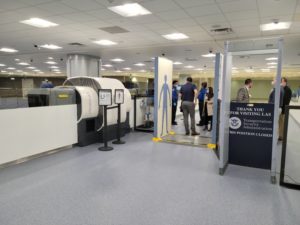
Of course, identity is only part of the equation. Airports still need to scan luggage, and will soon be using CT machines to do so. The Innovation Checkpoint currently has four different kinds of CT machines, with offerings from Clearscan, IDSS, Smith Detection, and Analogic. The machines differ slightly in terms of features and design, but all use some form of computed tomography (CT) tech to more accurately identify dangerous substances.
At the moment, people still need to take off their shoes and belts, take their laptops out of their bags, and store all of their liquids in a separate plastic bag. Each part of that process takes time, and adds precious minutes to the passenger journey as people take everything off and then put everything back on once they have been scanned.
The new CT scanners can eliminate at least two of those steps. I went through the Innovation Checkpoint on my way home from Las Vegas, and was able to leave my laptop in my carry-on when it went through the scanner. Liquids still need to go through in a plastic bag, though conversations with TSA agents during the tour indicated that even that may not be the case for too much longer. Passengers will eventually be able to place their carry-ons onto the conveyor belt as-is, without removing anything for standalone examination.
The CT scanners themselves utilize advanced X-ray technology to determine the atomic mass and density of any substance that goes through the machine. Developers are using machine learning to train the scanners to identify dangerous materials at the molecular level, which allows them to spot explosives while still allowing other liquids (like water) to pass through without any need for a secondary manual inspection.
So how well does it work? I can confirm that my security screening took much less time than normal. It certainly helps that the line for the Innovation Checkpoint was much, much shorter than the security line upstairs. Assembly and disassembly both took less time than usual, and that experience should only improve as the CT scanners learn how to recognize more items.
Arms to the Side

The same is true when airport security is scanning people. Right now, passengers are asked to pass through metal detectors while their luggage is getting scanned, and to empty their pockets to make sure that their keys and coins do not set off any alarms.
Rohde & Schwarz is working on a solution that would minimize much of that extra hassle. The company’s QPS201 scanner essentially uses radio waves to create a map of a person’s body. The waves pass through the person’s clothes and bounce off their skin, and the system raises a red flag if those waves encounter any anomalies. For example, a watch will trigger an alert on the wrist, while a belt buckle will trigger an alert on the abdomen.
In doing so, the system lets TSA agents know exactly what they should be looking for when they perform a secondary inspection (passengers are also more willing to cooperate when they know what went wrong). The scan only takes a matter of seconds, and the Rohde & Schwarz system automatically transposes each anomaly to the right part of the person’s body. It is also extremely precise, to the point that it can distinguish the abdomen from the groin when identifying a belt buckle. That accuracy could dramatically improve the travel experience for some travelers, since a belt becomes far less likely to trigger a more invasive search.
The other key advantage of the Rohde & Schwarz system is that it is truly gender neutral, and will generate roughly the same image with the same anomalies regardless of the gender entered into the system. That mitigates the threat of human error, which can occur when TSA agents are processing thousands of passengers on a busy day.
Go With the Flow
The final piece of the puzzle is crowd control. At the Innovation Checkpoint, that is realized with the help of tall, mounted cameras (affectionally dubbed giraffes) that loom over each line and each screening checkpoint. Those cameras are paired with analytic software from CrowdVision, and count people (and processing times) to watch for chokepoints and potential inefficiencies.
On the backend, CrowdVision’s platform provides a color-coded image of an airport terminal that makes it easy for operators to identify problems in real time. The solution does not have any biometric or identification capabilities, and simply helps operators optimize their layouts to minimize congestion and move passengers as efficiently as possible.
All Aboard!
The show floor at FTE Global was a collection of discrete airport solutions. The McCarran Innovation Checkpoint, on the other hand, reveals what the travel experience will look like when all of those pieces are put together. It will still be few years before that experience becomes the norm, and there are a few regulatory hurdles that need to be cleared along the way.
Even so, there is plenty of reason to be optimistic about the future of air travel. Modern technologies will make it easier to balance convenience and security, and that should make people more comfortable about booking their next flight.
–
December 16, 2021 – by Eric Weiss


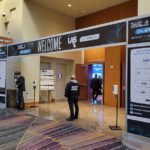


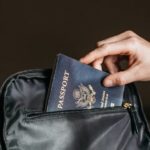

Follow Us